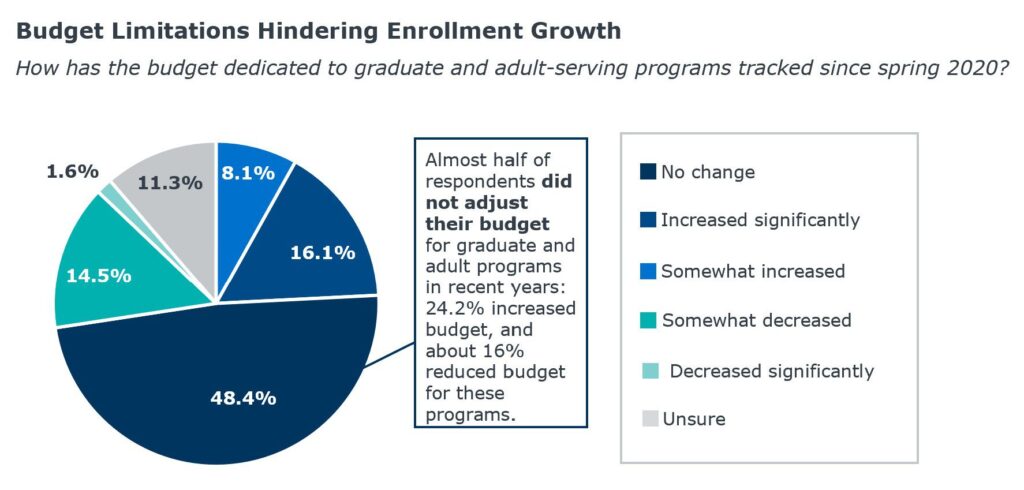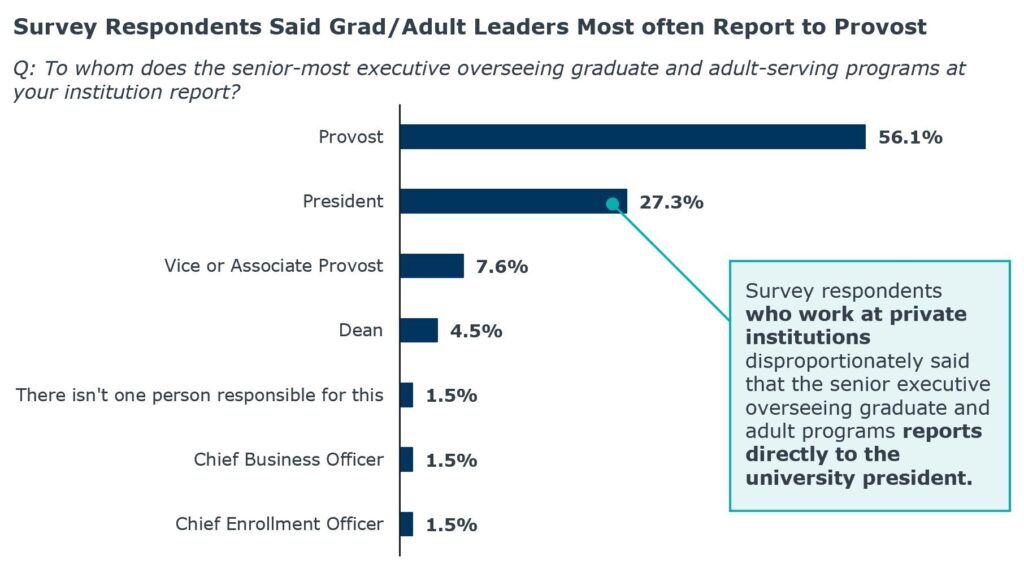The 4 biggest challenges facing graduate and adult education programs, according to presidents and provosts
Findings from EAB’s new survey of presidents, provosts, and VPEMs
December 5, 2022, By Tess Arena, Director, Product Marketing
The pressure is on for graduate programs. As undergraduate enrollment and net tuition revenue continue to fall, university leaders are doubling down on graduate and other adult-serving programs as a source of enrollment and revenue. But the graduate market is not without its own set of challenges. For the first time in nearly a decade, graduate enrollment declined in 2021 and 2022, according to NSC projections.
We recently surveyed university presidents, provosts, and VPEMs to quantify the challenges institutions face in growing enrollment in graduate and adult-serving programs. Here are the top four challenges university leaders identified.
Survey Methodology
EAB’s Adult Learner Recruitment and University Research teams surveyed 64 university executives, including presidents, provosts, vice provosts, and vice presidents of enrollment management, in summer 2022. Fifty-seven percent of respondents work at private, not-for-profit institutions, while 43 percent work at public, not-for-profit institutions.
1. Competition
Unsurprisingly, more than half of survey respondents identified competition as one of the top barriers they face in growing grad and adult learner enrollments. University leaders surveyed are more concerned about competition from other universities (55% of respondents) than competition from non-university providers like Coursera or Grow with Google (11% of respondents).
Turn your non-university competitors into your collaborators
2. Resource limitations
Respondents identified “limited budget” as the second-most common barrier to enrollment growth. Nearly half of respondents did not adjust the budget allocated to graduate and adult-serving programs in recent years (thanks in no small part to the pandemic). About one-quarter of respondents were able to increase the budget for their graduate and adult programs in the last three years, while 16% lost budget for these programs.
-
52%
identified “limited budget” as a top challenge to growing graduate and adult education programs.

Budget limitations are also fueling an already dire staffing situation at many institutions. Data from the Bureau of Labor Statistics indicates that higher ed lost 11% of its total workforce in 2020 and 2021. And graduate and adult-serving units have not been immune. About 38% of survey respondents identified “limited staff” as an obstacle to growing enrollment in graduate and adult-serving programs specifically. This is no surprise, given sixty percent of university leaders surveyed said the number of staff supporting grad and adult programs has not increased in the last three years.
Here’s how one grad school with a small team grew enrollment by 8%
-
60%
of university leaders said the number of staff supporting graduate and adult programs has not changed since spring 2020.
Unfortunately, these talent challenges are not expected to dissipate any time soon. EAB and NAGAP’s surveys of graduate enrollment practitioners indicates 46 percent are considering leaving their current role due to increased workload, staffing shortages, and lack of support at work.
Graduate enrollment leaders are burned out. Here’s why—and how you can help.
3. Organizational uncertainty
Some of the most common questions our researchers receive about graduate, adult, and online education are related to organizational structure: Where should our unit “live” in the broader institution? To whom should the leader of graduate and adult programming report?
And in our survey, university leaders who work at public institutions disproportionately identified “coordinating efforts across the institution” and “lack of clear leadership for graduate and adult-serving programs” as top challenges.
At 56% of surveyed institutions, the senior-most executive over graduate and adult ed programs reports directly to the provost. The person responsible for graduate and adult programs reports to the president at 27% of institutions represented in our survey.

But perhaps the single most common question we receive related to organizational structure is: “should marketing efforts for our graduate and adult ed programs be centralized or decentralized?” Survey respondents are split in their approach to marketing. About 48% of survey respondents operate under a decentralized model, whether fully decentralized (13%) or somewhat decentralized, with marketing split across several units (36%). Another 47% use a fully centralized model, which can more easily facilitate knowledge-sharing and accelerate decision-making among marketing staff.
4. Lack of institutional expertise
University leaders also cited “lack of expertise”—specifically in recruiting students, delivering online offerings, and designing academic programs—as barriers to enrollment growth. As leaders of graduate and adult-serving programs know, recruiting this population requires a different approach than recruiting first-time, full-time undergrads. Adult learners’ mindset, priorities, and needs differ significantly. Marketing materials should speak to each individual student’s goals and concerns, based on what your team knows about their behavior and interests. But institutions often don’t have staff and resources to take this responsive, personalized approach required to enroll adult learners.
See how institutions grow grad, online, and adult learner enrollments
Despite these challenges, the university leaders we surveyed are optimistic about the potential to grow enrollment. Eighty-eight percent of survey respondents expect graduate and adult learner enrollments to grow at their institution in the next three years. Check out the full survey analysis for more information about the programs university leaders are prioritizing and the strategies they’re using to achieve this growth.

More Blogs

What it takes to win in grad and adult enrollment today

Our New Staffing Model Playbook for Higher Ed CMOs
